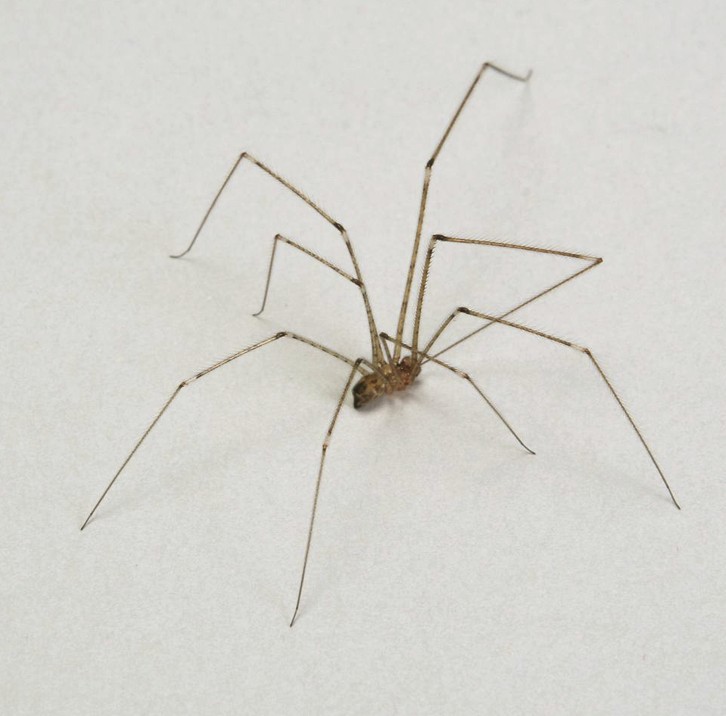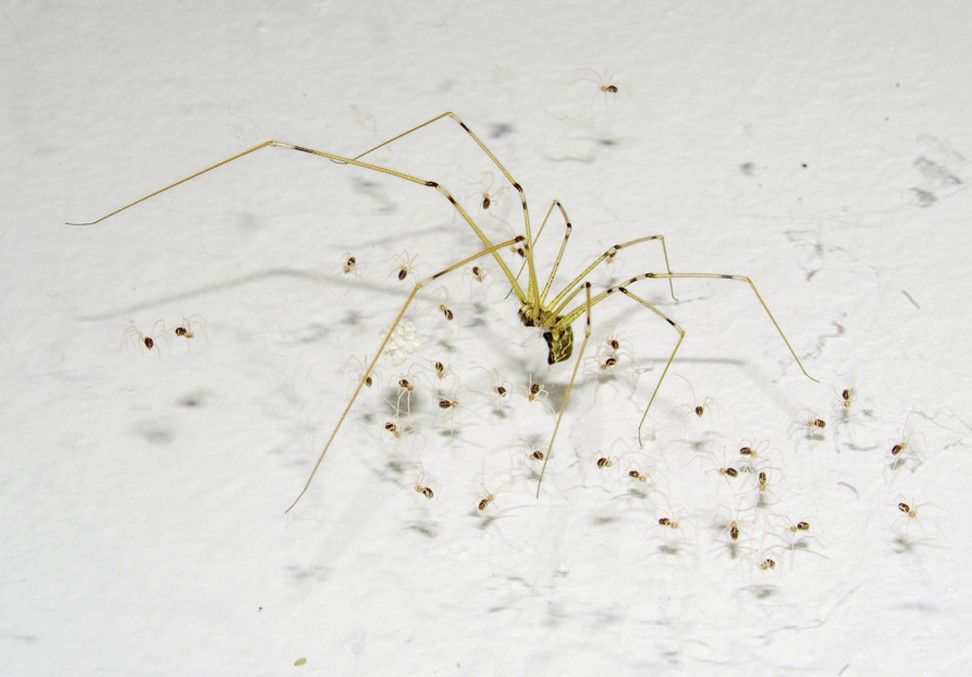Cellar Spiders
What are Cellar Spiders?

If you have been into your garage or any other damp areas around your property, chances are you probably encountered one of the most commonly found spider species in North America- the venomous cellar spider. Although their venom is considered to be quite dangerous, they are harmless to humans. These spiders are also known as “daddy long legs.” These arachnids are fond of damp and dark places with high humidity levels such as pantries, warehouses, closets, basements, and crawlspaces.
These spiders help to keep other insects from entering the inside of your home since they feed on ants, bugs, other spiders, and small invertebrates. Let’s look at the cellar spiders more closely and know everything about these small but long-legged arachnids from appearance to the habitat to behaviour to some of the most interesting facts.
How do Cellar Spiders look like?

The cellar spiders are thin and fragile creatures that are generally longer than most other species of spiders. Excluding the legs, their size ranges between 7-8 mm. Their legs are very long, and this is why they are often termed as “daddy long legs spiders.” Their size becomes at least six times longer, including the legs.
An adult female cellar spider is capable of growing as long as 50 mm. As with other spider species, cellar spiders have eight legs, a cephalothorax, and an abdomen. These arachnids look like a peanut and have fangs, venom glands, and eight eyes. Cellar spiders are usually tan or greyish-brown in colour.
What is their behaviour like?
Unlike other spider species, the webs of cellar spiders are entirely non-sticky. These spiders first envelop their prey before biting it. The bitten insect might be immediately consumed or stored for later. The cellar spiders tend to clean their cobwebs after finishing their food by unhooking and dropping the prey on the surface.
These arachnids behave strangely when threatened or entangled large prey. In response to a dangerous activity, the cellar spiders vibrate rapidly in a circular fashion in its web. This is why they are also known as “vibrating spiders.” Apparently, the reason behind this unusual behaviour is that the vibrations make these spiders almost invisible or blur due to which their predator fails to spot them. It is also assumed that the cellar spiders use these vibrations asking a predator to leave. Such signals also make it easy to grab the insects that just touched their webs and are still roaming nearby. If these spiders continue to feel troubled, they will corner themselves or drop from its web and quickly disappear.
What kind of Habitat do they need?
The cellar spiders prefer to live in temperate, tropical, and terrestrial habitats where the humidity levels are considerably high. They are known as cellar spiders due to their fondness for the damp cellar, crawl spaces, loose bark, abandoned animal burrows, basements, garages, warehouses, dark caves, rock cracks and other quiet corners of a home or building. They can be found year-round in heated structures. These arachnids can be found anywhere in the world except Antarctica since the temperature there is too cold for them to survive.
What do Cellar spiders Eat?
As with any other species of spiders, cellar spiders are successful predators. Their diet consists primarily of moths, insects, gnats, flies, mosquitoes, ants, spiders, and small invertebrates. The three-dimensional web of these arachnids is used like a prey-detection system. These spiders instantly come out, grab and consume their prey as soon as the insect or other spider bumps into their cobweb. When times are tough, and they don’t get enough food supplies in their environment, the cellar spiders visit and raid the webs of other spiders.
In order to confuse their predators or other spiders, the cellar spiders use their vibrating movements and pretend like a helpless insect stuck in the web. As soon as the unsuspecting spider leaps out in an attempt to catch and eat it, the cellar spider attacks it and makes the other spider its dinner.
Do Cellar spiders Bite Humans?
Although the venom of cellar spiders is considered to be the deadliest of any arachnid, they are not known to bite humans. Apparently, their fangs (chelicerae) are too small or weak to puncture human skin. Even if they bite once in a while, the bites are not medically significant, and the effects don’t last too long. Cellar spiders might prefer to run away rather than biting humans; however, as with any living being, they might bite if troubled unnecessarily causing a minor irritation on the skin. So basically these spiders are harmless to humans and won’t bite you unless you look like an insect or another spider.
Pictures
Take a look at some more pictures of cellar spiders:



Signs of Cellar Spiders Infestation
It’s true that cellar spiders are harmless to humans and helps in keeping away other bugs and spiders, but honestly, nobody likes to have spiders of any kind in their homes. If you are anything like me, you sure are scared of spiders and get creeped out when you see them hanging above your head. Not only this, these spiders tend to build new webs without taking down the older ones, causing an overabundance of unwanted webs in the corners of the house. To get rid of these spiders, you must first know the signs of their infestations.
Signs:
- One of the most visible signs of infestation caused by cellar spiders is the presence of cobwebs. Unlike other spider species, cellar spiders do not take their old webs down; instead, they expand on their existing webs. So, if you notice expansive areas of flimsy or haphazard webbing, you sure have an infestation at your home.
- A cluster of adult cellar spiders (living or dead) in damp and dark areas like garages, basements, warehouses, corners of closets and rock piles points to an infestation problem.
- Finding many eggs of cellar spiders also suggests a problematic situation as these spiders can lay up to 60 eggs at a time which helps them multiply their population in no time.
How to Get Rid of Cellar Spiders?
Follow these tips to get rid of cellar spiders as soon as you detect their infestation:
- As with any other species of spiders, the webs of cellar spiders are quite easy to remove with the help of a broom or vacuum cleaner. Remove all visible adults, egg sacs and spiders and don’t forget to empty the garbage or vacuum bag outdoors into a sealable trash bin.
- Take preventive and control measures to reduce the available food sources for the cellar spiders such as insects, other spiders, and small invertebrates.
- To keep the cellar spiders and the insects they feed on from entering your property, seal cracks, holes, gaps, and crevices around the foundation of your home/building and exterior walls especially doors, windows, and other entry points.
- Installing door sweeps on all possible entry points will also help to keep the spiders and other insects out.
- Control the internal humidity levels with proper ventilation and dehumidifiers. Low internal humidity levels thwart bugs and hence prevent cellar spiders.
- Replace white outdoor lighting to yellow in order to deter the infestations caused by cellar spiders.
- Use Glue traps to prevent their entry inside.
- Inspect their common habitat areas regularly so that any new webs can be destroyed immediately.
- Use insecticides to kill these spiders and keep their webs from returning on surfaces. However, chemical methods are only effective when combined with good sanitation practices. So, always use insecticides after trying out non-chemical methods.
- In the case of widespread infestation, take help from a licensed pest control company.
Interesting Facts about Cellar Spiders
- Cellar spiders or Pholcidae are often confused with harvestmen, and crane flies as they are also called daddy-long-legs.
- Cellar spiders belong to the sub-order Araneomorphae which contains approximately 1500 species divided into 80 genera.
- In order to protect their eggs from predators, the adult female cellar spiders encase the eggs in silk webs.
- There are approximately 20 species of cellar spiders in USA and Canada.
- These spiders tend to eat the end of their own legs when it gets too long.
- The adult female cellar spiders are comparatively longer than the adult male spiders.
- There are few species of cellar spiders that only have six eyes.
- Cellar spiders can easily survive in desert areas.
- The cellar spiders can even attack and kill one of the most dangerous spiders ever- The redback spiders.
- The daddy long-leg spiders can even eat jumping spiders, huntsman spiders and the spiders belonging to the Tegenaria species.
- When times get tough, and food is scarce, cellar spider can even eat another cellar spider.
We hope you enjoyed reading about these dangerous but human-friendly house pests. So, next time, when you spot a cellar spider, don’t get scared as it won’t bite you. Just use the tips provided by us in this article to get rid of these daddy long-legs spiders.
